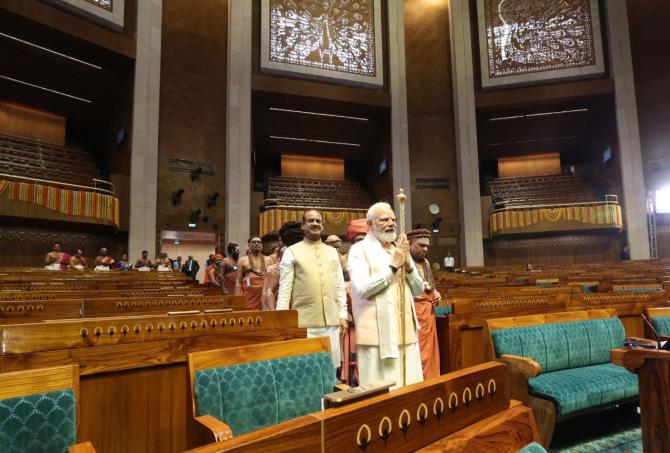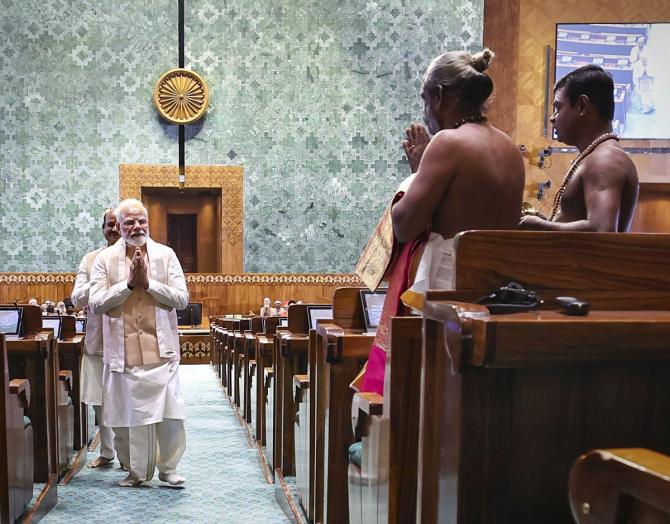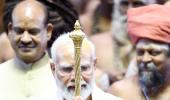The BJP seems wanting to return to a 'Tamil Hindutva' agenda for elections in Tamil Nadu, explains N Sathiya Moorthy.

Days after it all began, the Sengol controversy, or whatever passes off as a controversy therein, centred on Prime Minister Narendra D Modi and the Centre refuses to go away.
It is especially so in Dravidian Tamil Nadu, where it is all otherwise centred on, with some social media posts raising more questions in recent days, about the form and content of what that a traditional sceptre has come to represent in the people's eyes over decades and centuries.
First, there was the question of 'two Sengols', one presented by the Thiruvavaduthurai adheenam and another by the Madurai adheenam. Along with a host of other Saivite seers who made it to Delhi, their peetams are located mostly in southern Tamil Nadu.
The commonality in their approach is in their praise for Lord Siva in chaste Tamil poetry, dating back to a millennium or so.
The peetams or adheenams, when founded worked for Hindu revivalism the same way Adi Sankara, for instance, worked, but by employing Sanskrit as the language of his poetry and logical arguments with Buddhist and Jain monks who were becoming a fading class all across the country, especially Tamil Nadu.
Incidentally, there are about a lakh Tamil Jains living in Tamil Nadu, whose ancestors date back to that period. They are different from later day Marwari Jains, who migrated for business over the past four or five centuries or even decades.
It is this Tamil-centric traits of Hindu revivalism in Tamil Nadu of yore that is also behind the non-acceptance of Sanskrit and Hindi as a common language for the entire nation, when Gandhiji flagged it in the thirties.
There is the more visible 'anti-Hindi protests', launched first by Periyar E V Ramasamy Naicker in the late 1930s when the C Rajagopalachari-led Congress presidency government, followed by the bigger one launched by the DMK in the mid-sixties.
Yet, the real reason why most Tamils are religious (unlike often believed in north India) is also because they get to sing the Lord's praise in the language they know and understand, though that too is fast fading.
Incidentally, in the other Hindu tradition of Vaishavism, those in Tamil Nadu sing the praise of Lord Vishnu mostly in Tamil, cutting across caste lines.
The Brahminical upper caste bhakts of Lord Siva render most of their hymns and mantras in Sanskrit. In Vaishnavism in the Tamil country, most hymns are in Tamil and the language.
Both Iyengar Brahmins and their non-Brahmin brethren sing from the collection called Naalaayira Dhivya Prabhantham or Prabhantham for short.

As for the Sengol, traditionally the rajguru handed it over to the king on the latter assuming office, after crowning him. But it is not exclusive to the Chola dynasty as even some news anchors and columnists claimed in the run-up to the event in which Modi installed the former at the seat of democratic power in the Lok Sabha.
From now on, it will be there on the Speaker's podium with pomp and religiosity adding a traditional flavour in equal measure at the installation ceremony. But the way parliamentarians conduct business in the House over the past several years, it would be a reminder to the righteousness and duty that is missing in action.
Sure enough, on some occasion in the none-too-distant future, Modi is likely to swear by the Sengol while taunting the Opposition, without looking inward even for a moment -- as has been his style of functioning all through.
Two questions are doing the social media rounds. One is this: Why did two adheenams present two separate Sengols to the PM when rulers of the yore carried only one?
The conventional exception is when a king annexes another kingdom and takes the Sengol of the conquered ruler, to prove a point -- whether of surrender or total annihilation of the enemy.
More often than not, on such occasions, conscious effort used to be made to obliterate all images and imageries identified with the conquered lest they should feed a rebellious mind in the latter.
The second question in the post-Sengol presentation is about the arrest of women wrestlers in capital Delhi for demanding the arrest of a BJP parliamentarian, whom they alleged demanded sexual favours for a place in the Indian squad.
By the time the wrestlers, including Olympians, were arrested, social media had convinced the people that the ruling BJP was protecting Brij Bhushan Singh, the controversial ex-president of the Wrestling Federation of India, because he 'decided' the electoral fate of parties in four or five Lok Sabha seats in his state, what with the Lok Sabha polls only a year away.
Contextualised to the presentation of the Sengol to Modi, with the imagery of righteousness conferred on both, whether by design or otherwise, the timing of the women wrestlers' arrest is being compared to the demand for justice by Kannagi, the female protagonist of the Silappadikaram, one of the five great Tamil epics dating back close to two millennia.
After drawing a parallel to Kannagi demanding justice from the Pandya king in his open court, social media activists have this to say: 'In the Silappadikaram, the Pandya king lays down his life on the throne after Kannagi proved that he had ordered the beheading of her husband Kovalan for allegedly stealing the queen's anklet.'
Kannagi charged the king with non-application of mind and facts -- and had thus failing in the dharmic path of his ancestors. Some posts also quote from the Silappadikaram, where the king falls down dead on realising the truth, by uttering the poet Ilango Adigal's best one-liner of all times: 'Yaano arasan? Yaane kalvan.'
Translated, those four words, forming the dying declaration of the king, mean, 'Am I the king? No, I am the thief.'
Here, in the contemporary context, social media points out how when a group of young women wrestlers appeal to the man holding the Sengol to render justice to them, they are being arrested as if in punishment, for all the faults of the other man, who happens to be a powerful BJP parliamentarian.

It is anybody's guess as to who divined the Sengol as symbol for a popular democracy. Yet, in yore, either the rajguru or the adheenam was conventionally conferred the privilege or the right to hand over the Sengol to the new ruler on assuming office.
So much so, there is even a Sengol adheenam in southern Tamil Nadu, whose peedathipathi, or aadheenam, used to hand over the sceptre to the Pandya kings in their times.
That very idea of the dawn of Independence has now been revived 76 long years after then governor general Lord Louis Mountbatten reportedly handed over a sceptre, presented by the Thiruvavaduthurai adheenam, to then prime minister Jawaharlal Nehru, to mark the transfer of power from the British colonial monarchy to the people of India.
Later-day write-ups based on possible news reports of the event(s) indicate that Nehru, given his strong faith in democracy, had discouraged to show up the Sengol as a symbol of democratic traditions, which he wanted the nation to imbibe.
Of course, there are questions about the truthfulness of the events dating back to the days prior to Independence.
At least a part of it all has been proven, yes, by the late DMK founder C N Annadurai's word of caution to Nehru about his accepting the Sengol from the Thiruvaduthurai adheenam. But Annadurai's piece of advice for Nehru, published in the weekly Dravida Nadu of which he was the editor (issue date: August 24, 1947) at least mentions that a Sengol was presented, by the adheenam to Nehru.
There is no mention in Annadurai's weekly column of Mountbatten and transfer-of-power in what is possibly the only published account of the same. Annadurai specifically asks if any note from the adheenam accompanied the Sengol.
If so, what did it contain? If not, did Nehru, the author of Discovery of India was even told what the Sengol signified in the first place?
Hence, some in Tamil Nadu at least argue that that Sengol was not involved in the transfer of power at Independence. If so, was it meant to signify the adheenam's prayers for the new nation, and a caution to the new government on the righteousness of governance?
There are no answers. But then, definitely the message of the Sengol did not reach those in whose care that Sengol rested then. Otherwise, there was no way it could have been labelled as a 'golden walking stick', though even in those times -- and rarely since -- zamindars and other rich men used to carry gold-plated walking staff and walking sticks.
Now that the Sengol is at the centre of a national event and also an accompanying yet avoidable national controversy, it is sure to find repeated mention in Tamil social media in the weeks and months to come until after the Lok Sabha polls, if only to taunt Modi and the ruling BJP at the Centre.
It is akin to the frequent rediscovery of demonetisation, black money repatriation, and oil prices in social media posts across the country for the past few years.
In context, the critics of Modi and the BJP in Tamil Nadu can be expected to be active in the game through the coming weeks and months. They mostly belong to peripheral pan-Tamil groups.
The ruling DMK, which is also on a transitional route, slowly but surely, to one of accepting religion, more so majority Hinduism, as if it is also a reality of life, has been stone deaf and silent on the issue.

But it is the BJP-Hindutva cadres and other brands of Modi bhakts who have been celebrating at the start, only to forget those starting points, to be willing to defend their earlier cause till the very end.
It is not to question the belief, but to point to their lack of continuity and/or sincerity for them to stay on track on specific issues.
In the absence of such an approach, as otherwise happens in the rest of the country in matters Hindutva, Hindutva nationalism and the 21st century BJP's brand of nationalism, in Tamil Nadu, they heap one idea after another in double-quick succession, with the result, there is no clarity in the unconverted common people about what it all signifies, if at all.
Instead, they stand out only as one more in their Modi hagiography, especially since he became prime minister. In doing so, the BJP itself seems wanting to return to a 'Tamil Hindutva' agenda for elections in Tamil Nadu, despite the repeated hits that the party and its ruling AIADMK ally got in the Lok Sabha polls of 2019 and the assembly polls in 2021.
It was thus that then BJP state president L Murugan, now an Union minister, re-invented Hindutva for the Dravidian country, by joining whipped-up controversies over a 'Dravidian' poet and popular lyricist Vairamuthu made a passing reference to Sri Andal, one of the 12 Vaishnavite seers or Alwars, and the only woman among them. It did not click or work.
It was the case also with Murugan's Vetrivel Yatra, to the six important abodes of Lord Murugan whose name wrongly got frequent and early mention in the north Indian narratives on the Sengol now.
The Vetrivel Yatra was in response to old video footage that made rather objectionable references to the Kanda Sashti Kavasam, the Tamil hymns in praise of Lord Murugan.
A peripheral group had made those objectionable references in a YouTube channel. Their existence itself was not known to most people until BJP's Murugan made a song and dance of it.
Murugan's successor K Annamalai, the incumbent, managed slowly but surely to divert the party's agenda for the state from Tamil Hindutva that did not help, to typical political issues like corruption and lawlessness against Chief Minister M K Stalin's incumbent DMK government.
Though there is nothing much to show that the BJP's vote-bank has swollen under Annamalai, by introducing the Sengol issue into national political discourse, aides of the prime minister may have rekindled inherent Tamil apprehensions about the BJP's Hindutva agenda, if one discounted the high drama that accompanied the significant installation of the Sengol in Parliament, the seat of people's power in this country.
N Sathiya Moorthy, veteran journalist and political analyst, based in Chennai, is the author of J2J - Justice Party to Jayalalithaa: The Success Story of Dravidian Polity.










